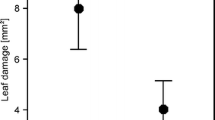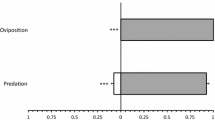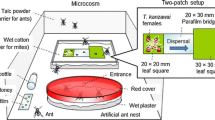Abstract
Prey refuges are expected to affect population dynamics, but direct experimental tests of this hypothesis are scarce. Larvae of western flower thrips Frankliniella occidentalis use the web produced by spider mites as a refuge from predation by the predatory mite Neoseiulus cucumeris. Thrips incur a cost of using the refuge through reduced food quality within the web due to spider mite herbivory, resulting in a reduction of thrips developmental rate. These individual costs and benefits of refuge use were incorporated in a stage-structured predator–prey model developed for this system. The model predicted higher thrips numbers in presence than in absence of the refuge during the initial phase. A greenhouse experiment was carried out to test this prediction: the dynamics of thrips and their predators was followed on plants damaged by spider mites, either with or without web. Thrips densities in presence of predators were higher on plants with web than on unwebbed plants after 3 weeks. Experimental data fitted model predictions, indicating that individual-level measurements of refuge costs and benefits can be extrapolated to the level of interacting populations. Model-derived calculations of thrips population growth rate enable the estimation of the minimum predator density at which thrips benefit from using the web as a refuge. The model also predicted a minor effect of the refuge on the prey density at equilibrium, indicating that the effect of refuges on population dynamics hinges on the temporal scale considered.





Similar content being viewed by others
References
Agrawal AA, Kobayashi C, Thaler JS (1999) Influence of prey availability and induced plant resistance on omnivory by western flower thrips. Ecology 80:518–523
Arendt JD, Reznick DN (2005) Evolution of juvenile growth rates in female guppies (Poecilia reticulata): predator regime or resource level? Proc R Soc Lond B 272:333–337
Brødsgaard HF, Hansen LS (1992) Effect of Amblyseius cucumeris and Amblyseius barkeri as biological control agents of Thrips tabaci on glasshouse cucumbers. Biocontrol Sci Technol 2:215–223
Brommer JE (2000) The evolution of fitness in life-history theory. Biol Rev 75:377–404
Caley MJ, StJohn J (1996) Refuge availability structures assemblages of tropical reef fishes. J Anim Ecol 65:414–428
Castineras A, Baranowski RM, Glenn H (1997) Distribution of Neoseiulus cucumeris (Acarina: Phytoseiidae) and its prey, Thrips palmi (Thysanoptera: thripidae) within eggplants in South Florida. Fla Entomol 80:211–217
Chase JM (1999) Food web effects of prey size refugia: variable interactions and alternative stable equilibria. Am Nat 154:559–570
Crawley MJ (1992) Population dynamics of natural enemies and their prey. In: Crawley MJ (ed) Natural enemies—the population biology of predators, parasites and diseases. Blackwell, Oxford, pp 40–89
De Courcy Williams ME (2001) Biological control of thrips on ornamental crops: interactions between the predatory mite Neoseiulus cucumeris (Acari: Phytoseiidae) and western flower thrips, Frankliniella occidentalis (Thysanoptera: Thripidae) on cyclamen. Biocontrol Sci Technol 11:41–55
Draper NR, Smith H (1981) Applied regression analysis, 2nd edn. Wiley, New York
Easterbrook MA, Fitz Gerald JD, Solomon MG (2001) Biological control of strawberry tarsonemid mite Phytonemus pallidus and two-spotted spider mite Tetranychus urticae on strawberry in the UK using species of Neoseiulus (Amblyseius) (Acari: Phytoseiidae). Exp Appl Acarol 25:25–36
Eklov P, Persson L (1995) Species-specific antipredator capacities and prey refuges: interactions between piscivorous perch (Perca fluviatilis) and juvenile perch (Rutilus rutilus). Behav Ecol Sociobiol 37:169–178
Field A (2000) Discovering statistics using SPSS for Windows. SAGE, London
Gerson U (1985) Webbing. In: Sabelis MW, Helle W (eds) Spider mites, vol 1A. Elsevier, Amsterdam, pp 223–232
Gillespie DR (1989) Biological control of thrips (Thysanoptera: thripidae) on greenhouse cucumber by Amblyseius cucumeris. Entomophaga 34:185–192
Hao X, Shipp JL, Wang K, Papadopoulos AP, Binns MR (2002) Impact of western flower thrips on growth, photosynthesis and productivity of greenhouse cucumber. Sci Hortic 92:187–203
Higgins CJ (1992) Western flower thrips (Thysanoptera: Thripidae) in greenhouses: population dynamics, distribution on plants and associations with predators. J Econ Entomol 85:1891–1903
Holbrook SJ, Schmitt RJ (2002) Competition for shelter space causes density-dependent predation mortality in damselfishes. Ecology 83:2855–2688
Ihaka R, Gentleman R (1996) R: a language for data analysis and graphics. J Comput Graph Stat 5:299–314
Jacobson R, Croft P, Fenlon J (2001) Suppressing establishment of Frankliniella occidentalis Pergande (Thysanoptera: Thripidae) in cucumber crops by prophylactic release of Amblyseius cucumeris Oudemans (Acarina: Phytoseiidae). Biocontrol Sci Technol 11:27–34
Krivan V (1997) Dynamic ideal free distribution: effects of optimal patch choice on predator–prey dynamics. Am Nat 149:164–178
Krivan V (1998) Effects of optimal antipredator behavior of prey on predator–prey dynamics: the role of refuges. Theor Popul Biol 53:131–142
Lima SL (1998) Nonlethal effects in the ecology of predator–prey interactions. BioScience 48:25–34
Lotka A (1922) The stability of the normal age distribution. Proc Natl Acad Sci USA 8:339–345
Magalhães S, Janssen A, Hanna R, Sabelis MW (2002) Flexible antipredator behaviour in herbivorous mites through vertical migration in a plant. Oecologia 132:143–149
Magalhães S, Janssen A, Montserrat M, Sabelis MW (2005) Host-plant species modifies the diet of an omnivore feeding on three trophic levels. Oikos 111:47–56
Martin J, Lopez P (1999) When to come out of a refuge: risk-sensitive and state-dependent decisions in an alpine lizard. Behav Ecol 10:487–492
Martin J, Lopez P, Cooper WE (2003a) Loss of mating opportunities influences refuge use in the Iberian rock lizard, Lacerta monticola. Behav Ecol Sociobiol 54:505–510
Martin J, Lopez P, Cooper WE (2003b) When to come out of a refuge: balancing predation risk and foraging opportunities in an alpine lizard. Ethology 109:77–87
McNair JN (1986) The effect of refuges on predator–prey dynamics: a reconsideration. Theor Popul Biol 29:38–63
Meyer JJ, Byers JE (2005) As good as dead? Sublethal predation facilitates lethal predation on an intertidal clam. Ecol Lett 8:160–166
Murdoch WW, Nisbet RM, Blythe SP, Gurney WSC, Reeve JD (1987) An invulnerable age class and stability in delay-differential parasitoid-hosts models. Am Nat 128:263–282
Mylius SD, Diekmann O (1995) On evolutionary stable life histories, optimization and the need to be specific about density dependence. Oikos 74:218–224
Pallini A, Janssen A, Sabelis MW (1998) Predators induce interspecific herbivore competition for food in refuge space. Ecol Lett 1:171–177
Persson L (1993) Predator-mediated competition in prey refuges: the importance of habitat dependent prey resources. Oikos 68:12–22
Persson L, de Roos AM (2003) Adaptive habitat use in size-structured populations: linking individual behavior to population dynamics. Ecology 84:1129–1139
Polo V, Lopez P, Martin J (2005) Balancing the thermal costs and benefits of refuge use to cope with persistent attacks from predators: a model and an experiment with an alpine lizard. Evol Ecol Res 7:23–35
Rangeley RW, Kramer DL (1998) Density dependent antipredator tactics and habitat selection in juvenile pollock. Ecology 79:943–952
de Roos AM, Leonardsson K, Persson L, Mittelbach GG (2002) Ontogenetic niche shifts and flexible behavior in size-structured populations. Ecol Monogr 72:271–292
Sabelis MW (1981) Biological control of two-spotted spider mites using phytoseiid predators. Part 1. PhD Dissertation. University of Wageningen
Sabelis MW, Bakker FM (1992) How predatory mites cope with the web of their tetranychid prey—a functional view on dorsal chaetotaxy in the phytoseiidae. Exp Appl Acarol 16:203–225
Schmitz OJ, Beckerman AP, O’Brien KM (1997) Behaviorally mediated trophic cascades: effects of predation risk on food web interactions. Ecology 78:1388–1399
Sih A (1987) Prey refuges and predator–prey stability. Theor Popul Biol 31:1–12
Skalski GT, Gilliam JF (2002) Feeding under predation hazard: testing models of adaptive behavior with stream fish. Am Nat 160:158–172
Steiner MY (1990) Determining population characteristics and sampling procedures for the western flower thrips (Thysanoptera: Thripidae) and the predatory mite Amblyseius cucumeris (acari:Phytoseiidae) on cucumber. Environ Entomol 19:1605–1613
Trichilo PJ, Leigh TF (1986) Predation on spider mite eggs by the western flower thrips, Frankliniella occidentalis (Thysanoptera: Thripidae), an opportunist in a cotton agroecosystem. Environ Entomol 15:821–825
van Baalen M, Sabelis MW (1993) Coevolution of patch selection strategies of predators and prey and the consequences for evolutionary stability. Am Nat 142:646–670
van Baalen M, Sabelis MW (1999) Nonequilibrium population dynamics of “ideal and free” prey and predators. Am Nat 154:69–88
van der Hoeven WAD, van Rijn PCJ (1990) Factors affecting the attack success of predatory mites on thrips larvae. Proc Exp Appl Entomol 1:25–30
van Houten YM, van Stratum P (1995) Control of Western flower thrips in winter with Amblyseius cucumeris (Oudemans) and A. degenerans (Berlese). In: Parker BL (ed) Thrips biology and management. Plenum Press, New York, pp 245–248
van Rijn PCJ, Tanigoshi LK (1999) The contribution of extrafloral nectar to survival and reproduction of the predatory mite Iphiseius degenerans on Ricinus communis. Exp Appl Acarol 23:281–296
van Rijn PCJ, Mollema C, Steenhuis-Broers GM (1995) Comparative life-history studies of Frankliniella occidentalis and Thrips tabaci (Thysanoptera, thripidae) on cucumber. Bull Entomol Res 85:285–297
van Rijn PCJ, van Houten YM, Sabelis MW (2002) How plants benefit from providing food to predators when it is also edible to herbivores. Ecology 83:2664–2679
van Rijn PCJ, Bakker FM, van der Hoeven WAD, Sabelis MW (2005) Is arthropod predation exclusively satiation-driven? Oikos 109:101–116
Vanimpe G, Hance T (1993) A technique for testing varietal susceptibility to the mite T-urticae—application to bean, cucumber, tomato and strawberry. Agronomie 13:739–749
Venzon M, Janssen A, Pallini A, Sabelis MW (2000) Diet of a polyphagous arthropod predator affects refuge seeking of its thrips prey. Anim Behav 60:369–375
Vos M, Kooi BW, De Angelis DL, Mooij WM (2004) Inducible defences and the paradox of enrichment. Oikos 105:471–480
Wilson LJ, Bauer LR, Walter GH (1996) ‘Phytophagous’ thrips are facultative predators of twospotted spider mites on cotton in Australia. Bull Entomol Res 86:297–305
Acknowledgments
We are grateful to Arne Janssen for many contributions to this manuscript and to Maria Nomikou, Belén Belliure, Erik van Gool, Brechtje Eshuis and Christian Tudorache for discussions. Ludek Tikovsky and Harold Lemereis are thanked for greenhouse arrangements. Ronaldo Reis Jr and Tom van Dooren provided invaluable help in the statistical analysis. SM was funded by the Portuguese Foundation for Science and Technology (FCT-Praxis XXI, scholarship reference SFRH/BD/818/2000) and AP by CNPq-Brazil. The experiments performed comply with the current laws of the Netherlands.
Author information
Authors and Affiliations
Corresponding author
Additional information
Communicated by Thomas Hoffmeister.
Sara Magalhães and Paul C. J. van Rijn have contributed equally to this work.
Rights and permissions
About this article
Cite this article
Magalhães, S., van Rijn, P.C.J., Montserrat, M. et al. Population dynamics of thrips prey and their mite predators in a refuge. Oecologia 150, 557–568 (2007). https://doi.org/10.1007/s00442-006-0548-3
Received:
Accepted:
Published:
Issue Date:
DOI: https://doi.org/10.1007/s00442-006-0548-3




